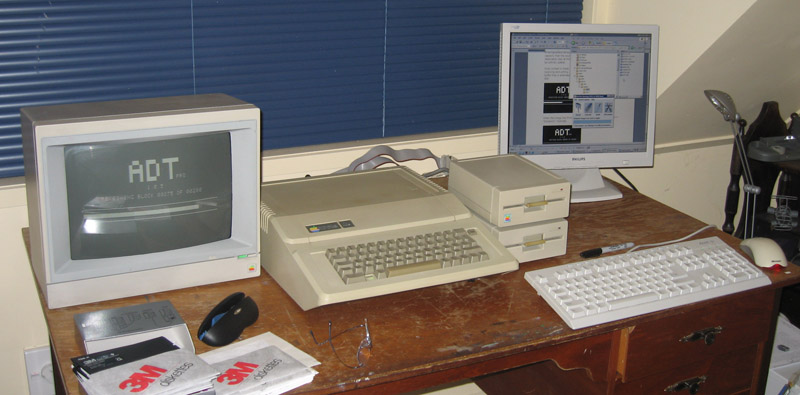| Tweet |
Making an Apple II boot disk (and getting other Apple II software) from disk images
Introduction
If you have found this page directly from an Internet search (as opposed to a link from my disk imaging introduction page) you have most likely missed some important information. Please click to READ THIS INTRODUCTORY PAGE FIRST. It explains some generic aspects of disk imaging and why, even if you DO have a good bootable disk, it may not work.

Figure 1. Transferring Apple II images to an Apple IIe using ADTPro
Hardware requirements
You'll need the following hardware:
- A disk-based Apple II/II+ or IIe with at least a cassette port OR a serial card OR a network card
- A PC running Linux, Mac OSX, OS/2 or Windows which contains the disk image file
- The necessary cable to connect the two machines
- Blank 5.25" double density (not high density) floppy disks in good condition
In my case it was an Apple IIe with a super serial card and a null-modem cable connected to a Windows XP box.
Software
For the Apple II range, ATDPro is what you are looking for. The software is initially set up on a PC or Mac. This can then be used to "bootstrap" the Apple II, sending the Apple-required components over the cable and writing a self-booting ATDPro Client Apple transfer program on a blank disk in the Apple II drive. This client program can then be used to source and process disk images on the PC, and write them out to disk on the Apple. This includes a full PRODOS or Dos 3.3 disk. ADTPro can even write disks for the Apple III.
I found this program very easy to use and had no problems whatsoever. The documentation and support on the website is simply phenomenal. All the more so in that this program (being open source) is entirely free!! All kudos to the team.
Here's a YouTube video (not mine) that steps through the process. It also shows how to connect the two machines together and set the Apple super serial card dip switches. Check it out before you dive in!
Last words
Once the ATDPro client is in place you can create as many disks as you want, as easily as you want from the vast Apple repositories all over the web.
Have fun!
Tez
23rd December, 2011
| Tweet |